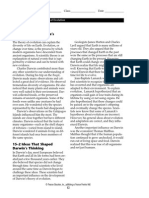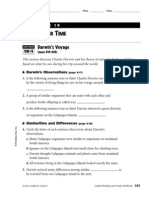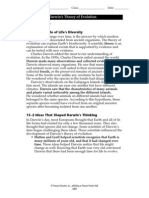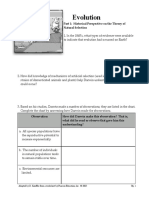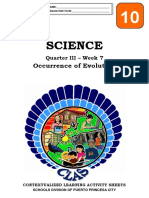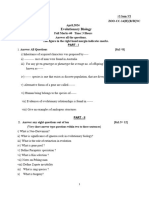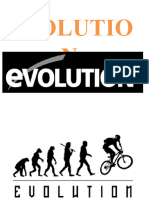Section 15-3 Darwin Presents His Case: Publication of On The Origin of Species
Section 15-3 Darwin Presents His Case: Publication of On The Origin of Species
Uploaded by
ali floresCopyright:
Available Formats
Section 15-3 Darwin Presents His Case: Publication of On The Origin of Species
Section 15-3 Darwin Presents His Case: Publication of On The Origin of Species
Uploaded by
ali floresOriginal Title
Copyright
Available Formats
Share this document
Did you find this document useful?
Is this content inappropriate?
Copyright:
Available Formats
Section 15-3 Darwin Presents His Case: Publication of On The Origin of Species
Section 15-3 Darwin Presents His Case: Publication of On The Origin of Species
Uploaded by
ali floresCopyright:
Available Formats
Name______________________________ Class___________________ Date_______________
Section 15-3 Darwin Presents His Case
(pages 378-386)
Key Concepts
• How is natural variation used in artificial selection?
• How is natural selection related to a species’ fitness?
• What evidence of evolution did Darwin present?
Publication of On the Origin of Species (pages 378-379)
1. Is the following sentence true or false? When Darwin returned to England, he rushed to
publish his thoughts about evolution.
1. The naturalist whose essay gave Darwin an incentive to publish his own work was
3. Circle the letter of each sentence that is true about Darwin’s book On the Origin
of Species.
a. It was published in 1869.
b. It was ignored when it was first published.
c. It contained evidence for evolution.
d. It described natural selection.
Inherited Variation and Artificial Selection (page 379)
4. Differences among individuals of a species are referred to as
5. Is the following sentence true or false? Genetic variation is found only in wild
organisms in nature.
6. Circle the letter of each sentence that is true about artificial selection.
a. It is also called selective breeding.
b. It occurs when humans select natural variations they find useful.
c. It produces organisms that look very different from their ancestors.
d. It is no longer used today.
Evolution by Natural Selection (pages 380-382)
7. What was Darwin’s greatest contribution?
Match each term with its definition.
Terms Definitions
________8. fitness a. Any inherited characteristic that increases an
________9. adaptation organism’s chance of survival
_______10. natural selection b. Survival of the fittest
c. The ability of an individual to survive and
reproduce in its specific environment
© Pearson Education, Inc., publishing as Pearson Prentice Hall.
18
Name______________________________ Class___________________ Date_______________
11. What does the phrase struggle for existence mean?
12. Is the following sentence true or false? Adaptations can be physical characteristics but not
more complex features such as behavior.
13. Explain what Darwin meant by the phrase survival of the fittest.
14. Circle the letter of each sentence that is true about natural selection.
a. It selects traits that increase fitness.
b. It takes place without human control.
c. It can be observed directly in nature.
d. It leads to an increase in a species’ fitness.
15. The principle that living species descend, with changes, from other species over time is
referred to as
15. The principle that all species were derived from common ancestors is known as
Evidence of Evolution (pages 382-385)
17. Is the following sentence true or false? Darwin argued that living things have been
evolving on Earth for thousands of years.
17. Complete the concept map.
Evidence for
Evolution
can be found in
The fossil record
19. How do fossils that formed in different rock layers provide evidence of evolution?
© Pearson Education, Inc., publishing as Pearson Prentice Hall.
19
Name______________________________ Class___________________ Date_______________
20. Circle the letter of the way Darwin explained the distribution of finch species on the
Galápagos Islands.
a. They had descended with modification from a common mainland ancestor.
b. They had descended with modification from several different mainland ancestors.
c. They had remained unchanged since arriving on the Galápagos from the mainland.
d. They had become more similar to one another after arriving on the Galápagos.
21. How did Darwin explain the existence of similar but unrelated species?
22. Structures that have different mature forms but develop from the same embryonic tissues
are called
23. Is the following sentence true or false? Homologous structures provide strong evidence that
all four-limbed vertebrates have descended, with modifications, from common
ancestors.
24. Organs that are so reduced in size that they are just vestiges, or traces, of homologous
organs in other species are called
Summary of Darwin’s Theory (page 386)
25. Circle the letter of each idea that is part of Darwin’s theory of evolution.
a. There is variation in nature.
b. Fewer organisms are produced than can survive.
c. There is a struggle for existence.
d. Species change over time.
26. According to Darwin’s theory, what happens to individuals whose characteristics are
not well suited to their environment?
27. Darwin believed that all organisms on Earth are united into a single tree of life by
Strengths and Weaknesses of Evolutionary Theory (page 386)
28. What is the status of Darwin’s hypotheses today?
© Pearson Education, Inc., publishing as Pearson Prentice Hall.
20
You might also like
- Evolution Close ReadingDocument2 pagesEvolution Close Readingapi-377700100100% (1)
- 12.4.3: Evolution Fill in The Blank WithDocument3 pages12.4.3: Evolution Fill in The Blank Withapi-25965241No ratings yet
- Biology Chapter 16 18 Evolution and Classification NotesDocument11 pagesBiology Chapter 16 18 Evolution and Classification NotesTiffany GallinaNo ratings yet
- Darwin's Theory of Evolution Chapter Test B: Multiple ChoiceDocument4 pagesDarwin's Theory of Evolution Chapter Test B: Multiple ChoiceSamuel CastanedaNo ratings yet
- Evolution Test ReviewDocument8 pagesEvolution Test Reviewapi-237316144No ratings yet
- Vanessa Combs - Evolution NotesDocument5 pagesVanessa Combs - Evolution Notesvancombs175No ratings yet
- Chapter 6 Lesson 1Document3 pagesChapter 6 Lesson 1Scratch thatNo ratings yet
- CH 15 WorkbookDocument10 pagesCH 15 Workbookapi-237586441100% (1)
- Darwin PracticeDocument11 pagesDarwin PracticeFaith WoonNo ratings yet
- 16.3 Darwin Presents His CaseDocument3 pages16.3 Darwin Presents His CaseAbdul Mohti ShahineNo ratings yet
- Natural Selection Guided NotesDocument4 pagesNatural Selection Guided Notescmillica1176No ratings yet
- 03ReadingGuide-DarwinDocument7 pages03ReadingGuide-Darwinlee66949354No ratings yet
- Evolution Test 2012Document10 pagesEvolution Test 2012369220No ratings yet
- Long Test 3 Ready To PrintDocument3 pagesLong Test 3 Ready To Printjayrald cruzadaNo ratings yet
- Finals - Biology 2Document12 pagesFinals - Biology 2Leonel Mendoza100% (1)
- Evolution Test: Multiple ChoiceDocument5 pagesEvolution Test: Multiple ChoiceJoshua WhiteNo ratings yet
- Answer Key Quiz 6Document1 pageAnswer Key Quiz 6Coronacion, Earl Vin T.No ratings yet
- Evolution Review Packet Key EditableDocument4 pagesEvolution Review Packet Key EditableMiljoy Delegado50% (2)
- Ch22 Decent With Modification A Darwinian View of LifeDocument4 pagesCh22 Decent With Modification A Darwinian View of LifeAdamSalazarNo ratings yet
- Reading Guide For Charles Darwin, On The Origin of Species, 1st EditionDocument6 pagesReading Guide For Charles Darwin, On The Origin of Species, 1st Editionb8245747No ratings yet
- Darwin and EvolDocument13 pagesDarwin and EvolDavid GiraldoNo ratings yet
- 3RD Gen - Bio 2Document4 pages3RD Gen - Bio 2ronasalilayNo ratings yet
- Interface Computer College 2Nd Unit Exam High School Department Grade 9 ScienceDocument5 pagesInterface Computer College 2Nd Unit Exam High School Department Grade 9 ScienceMara LabanderoNo ratings yet
- Adaptations & Inheritance Questions_ANSWERSDocument2 pagesAdaptations & Inheritance Questions_ANSWERSsarmila.cpeNo ratings yet
- Summative Test in General Biology 2Document2 pagesSummative Test in General Biology 2rolly baloNo ratings yet
- Quiz DarwinDocument2 pagesQuiz Darwinapi-288315149No ratings yet
- Evolution Test Review KeyDocument5 pagesEvolution Test Review Keyapi-242868690No ratings yet
- Evolution Practice Test 2 With AnswersDocument10 pagesEvolution Practice Test 2 With AnswersSuhani SinhaNo ratings yet
- 4 1 - Darwin's Theory of Evolution + 4 2 - Evidence of EvolutionDocument10 pages4 1 - Darwin's Theory of Evolution + 4 2 - Evidence of Evolutionalialdhmani305No ratings yet
- Weekend Worksheet 22Document4 pagesWeekend Worksheet 22niraj88947No ratings yet
- Biology M15 EvolutionDocument25 pagesBiology M15 EvolutionDiana Dealino-Sabandal0% (2)
- Bio Evolution Exam 1 ReviewDocument4 pagesBio Evolution Exam 1 Reviewmuskaanbhar0304No ratings yet
- GenBio2 Q3 M4Document22 pagesGenBio2 Q3 M4raffyrosel789No ratings yet
- Lesson 10.3-4Document7 pagesLesson 10.3-4tsrif0% (1)
- Evolution Test Bank 1Document20 pagesEvolution Test Bank 1alshalabinezardonia96No ratings yet
- Darwin's Theory of Evolution: Name - Class - DateDocument3 pagesDarwin's Theory of Evolution: Name - Class - DateAni Coca KollaNo ratings yet
- 3rd Quarter SciDocument6 pages3rd Quarter SciLovely Grace TormisNo ratings yet
- CH 10 11 Evolution Evidences 1Document97 pagesCH 10 11 Evolution Evidences 1Bukhari DiangkaNo ratings yet
- EvolutionDocument3 pagesEvolutionJessica NicholsonNo ratings yet
- Ruse, M. Charles Darwin's Theory of Evolution An AnalysDocument23 pagesRuse, M. Charles Darwin's Theory of Evolution An AnalysLoïc MarticuestNo ratings yet
- Charles Darwin _ 3 XDocument5 pagesCharles Darwin _ 3 XAsma ZehraNo ratings yet
- Natural Selection Study Guide KeyDocument8 pagesNatural Selection Study Guide Keykhaliqcee82No ratings yet
- Worksheet - Evolution PacketDocument10 pagesWorksheet - Evolution PacketjtNo ratings yet
- Science10 qIII Clas7 Occurrence-of-Evolution V6-Carissa-CalalinDocument10 pagesScience10 qIII Clas7 Occurrence-of-Evolution V6-Carissa-CalalinZy Baca OcoNo ratings yet
- Evolution Test 2Document7 pagesEvolution Test 2PT - 09SL 728582 John Fraser SSNo ratings yet
- Assessments 1-6Document7 pagesAssessments 1-6JohnlloydNo ratings yet
- Charles-Darwin-WPS-OfficeDocument3 pagesCharles-Darwin-WPS-Officelunadump422No ratings yet
- Summative TEstDocument14 pagesSummative TEstxoxkakidoxoxNo ratings yet
- CH 15 Test CDocument3 pagesCH 15 Test CLesley DanfordNo ratings yet
- Sunlight International School: Olaya, Riyadh, KSADocument35 pagesSunlight International School: Olaya, Riyadh, KSAJana AljundiNo ratings yet
- Biology: (Effective Alternative Secondary Education)Document25 pagesBiology: (Effective Alternative Secondary Education)Jonathan Tabbun100% (1)
- WEEK 2 - SummativeDocument1 pageWEEK 2 - SummativeCristelle EvangelistaNo ratings yet
- d0846503 Bio ch18 B 2 Files MergedDocument9 pagesd0846503 Bio ch18 B 2 Files Mergedapi-364565466100% (1)
- CH 22 GRDocument3 pagesCH 22 GRAnt Phongpandecha100% (2)
- Making of TheoryDocument3 pagesMaking of TheoryMSHYDERABAD4334No ratings yet
- Zoology Study Guide Chapter 01Document5 pagesZoology Study Guide Chapter 01Rauf AbNo ratings yet
- Origin and Evolution of Life 2Document12 pagesOrigin and Evolution of Life 2Shraddha BhandariNo ratings yet
- 11 Bio ch7-8 Quiz SolutionDocument4 pages11 Bio ch7-8 Quiz SolutionConnor BrooksNo ratings yet
- Evolution: How Life Adapts to a Changing Environment with 25 ProjectsFrom EverandEvolution: How Life Adapts to a Changing Environment with 25 ProjectsNo ratings yet
- Politically Incorrect Guide to Darwinism and Intelligent DesignFrom EverandPolitically Incorrect Guide to Darwinism and Intelligent DesignRating: 3.5 out of 5 stars3.5/5 (3)
- Chapter 8 Earthquakes and Society1Document7 pagesChapter 8 Earthquakes and Society1ali floresNo ratings yet
- Section 15-1 The Puzzle of Life's Diversity: Name Class DateDocument2 pagesSection 15-1 The Puzzle of Life's Diversity: Name Class Dateali floresNo ratings yet
- Section 15-2 Ideas That Shaped Darwin's Thinking: An Ancient, Changing EarthDocument2 pagesSection 15-2 Ideas That Shaped Darwin's Thinking: An Ancient, Changing Earthali floresNo ratings yet
- Brgs 6211Document5 pagesBrgs 6211ali floresNo ratings yet
- GenBio 2 Reviewer 4th MTDocument7 pagesGenBio 2 Reviewer 4th MTmhenly.estanislaoNo ratings yet
- From The Origin of Life To Evolutionary School of ThoughtDocument2 pagesFrom The Origin of Life To Evolutionary School of ThoughtJunell TadinaNo ratings yet
- Origin of Species: Chapter 18.2 and 18.3Document18 pagesOrigin of Species: Chapter 18.2 and 18.3Kayla GarciaNo ratings yet
- Comparative Social Evolution 1st Edition Dustin R. Rubenstein All Chapters Instant DownloadDocument65 pagesComparative Social Evolution 1st Edition Dustin R. Rubenstein All Chapters Instant Downloaddeckiesimboo100% (1)
- Darwinian Revolution Challenged Traditional Views of A Young Earth Inhabited by Unchanging Species by Suggesting Natural SelectionDocument3 pagesDarwinian Revolution Challenged Traditional Views of A Young Earth Inhabited by Unchanging Species by Suggesting Natural Selectionapi-289805116No ratings yet
- Natural Selection Lab Repor1Document3 pagesNatural Selection Lab Repor1api-280768687No ratings yet
- Uniqueness of Human CultureDocument3 pagesUniqueness of Human CultureVidit NarayanNo ratings yet
- The CHICKEN DocumentDocument6 pagesThe CHICKEN DocumentReena DominoNo ratings yet
- Love & Raff 2003Document4 pagesLove & Raff 2003Anonymous GXbE3sPWNo ratings yet
- ApomixisDocument6 pagesApomixisGrt grtNo ratings yet
- Adaptive Radiation - WikipediaDocument3 pagesAdaptive Radiation - Wikipediaskline3No ratings yet
- TSH CAPE Biology Unit 1 Class Notes 13Document12 pagesTSH CAPE Biology Unit 1 Class Notes 13chelsea AlexandriaNo ratings yet
- Evolution & Gene FrequenciesDocument20 pagesEvolution & Gene FrequenciesAsif JuttNo ratings yet
- Chapter 8Document4 pagesChapter 8api-239466415No ratings yet
- Unit-1 Introduction To Behavioral PsychologyDocument33 pagesUnit-1 Introduction To Behavioral PsychologyShahbaz aliNo ratings yet
- Ap: Chapter 24: The Origin of SpeciesDocument4 pagesAp: Chapter 24: The Origin of SpeciesEhsan RahmanNo ratings yet
- Zoo-Cc-14 H NCDocument2 pagesZoo-Cc-14 H NCyantramsaiNo ratings yet
- Cas Biology Chapter 30 PQ AnswersDocument3 pagesCas Biology Chapter 30 PQ AnswersMonayem HuqNo ratings yet
- Evolution Introduc QnsDocument2 pagesEvolution Introduc QnsHellö PëachNo ratings yet
- VariationDocument15 pagesVariationAnwita JhaNo ratings yet
- Biology Lab 2nd TermDocument9 pagesBiology Lab 2nd TermAna Sofia Guzman FernandezNo ratings yet
- A Primer of Operant ConditioningDocument59 pagesA Primer of Operant ConditioningUyen TranNo ratings yet
- Activity Sheet: What's MoreDocument4 pagesActivity Sheet: What's MoreMhike LaunicoNo ratings yet
- Living World Test 1Document2 pagesLiving World Test 1MRIDULANo ratings yet
- Republic of the PhilippinesDocument14 pagesRepublic of the PhilippinesAngela Delos SantosNo ratings yet
- Ernst Mayr Evolution PDFDocument2 pagesErnst Mayr Evolution PDFKaren0% (1)
- Bio001 EVOLUTIONDocument32 pagesBio001 EVOLUTIONeseighofoseNo ratings yet
- CU-2022 B.sc. (Honours) Zoology Semester-6 Paper-DSE-B (2) - 1 QPDocument2 pagesCU-2022 B.sc. (Honours) Zoology Semester-6 Paper-DSE-B (2) - 1 QPxcool0078No ratings yet
- Unit 3, Assesment of Learning, Unit Test - 3 (AutoRecovered)Document8 pagesUnit 3, Assesment of Learning, Unit Test - 3 (AutoRecovered)hewleetNo ratings yet
- Chapter 14 TESTDocument4 pagesChapter 14 TESTPak RisNo ratings yet







